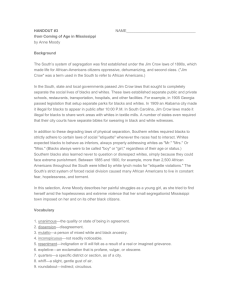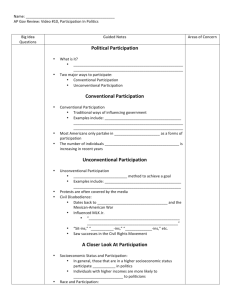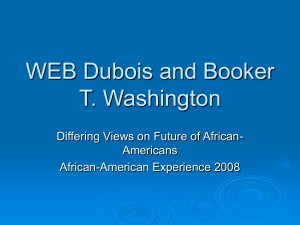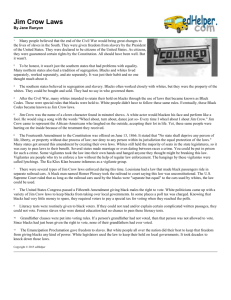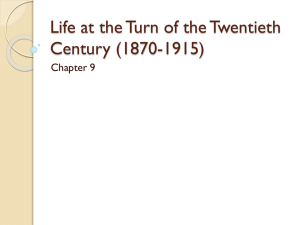Assignment: Impact Name:
advertisement
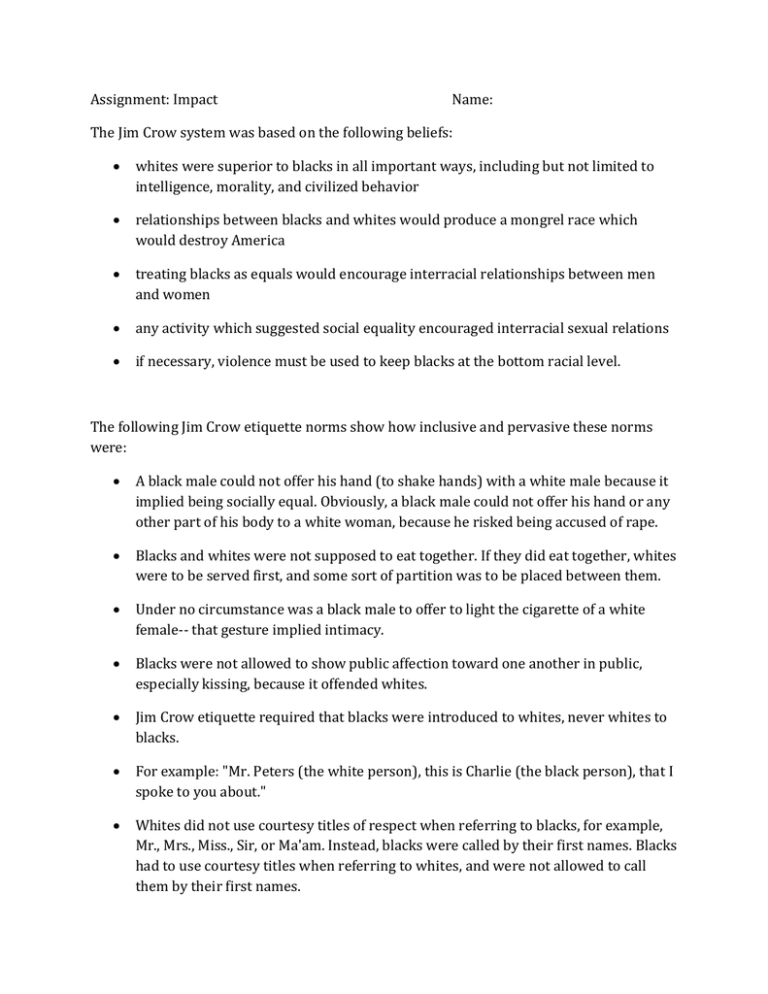
Assignment: Impact Name: The Jim Crow system was based on the following beliefs: whites were superior to blacks in all important ways, including but not limited to intelligence, morality, and civilized behavior relationships between blacks and whites would produce a mongrel race which would destroy America treating blacks as equals would encourage interracial relationships between men and women any activity which suggested social equality encouraged interracial sexual relations if necessary, violence must be used to keep blacks at the bottom racial level. The following Jim Crow etiquette norms show how inclusive and pervasive these norms were: A black male could not offer his hand (to shake hands) with a white male because it implied being socially equal. Obviously, a black male could not offer his hand or any other part of his body to a white woman, because he risked being accused of rape. Blacks and whites were not supposed to eat together. If they did eat together, whites were to be served first, and some sort of partition was to be placed between them. Under no circumstance was a black male to offer to light the cigarette of a white female-- that gesture implied intimacy. Blacks were not allowed to show public affection toward one another in public, especially kissing, because it offended whites. Jim Crow etiquette required that blacks were introduced to whites, never whites to blacks. For example: "Mr. Peters (the white person), this is Charlie (the black person), that I spoke to you about." Whites did not use courtesy titles of respect when referring to blacks, for example, Mr., Mrs., Miss., Sir, or Ma'am. Instead, blacks were called by their first names. Blacks had to use courtesy titles when referring to whites, and were not allowed to call them by their first names. If a black person rode in a car driven by a white person, the black person sat in the back seat or the back of a truck. Motorists had the right-of-way at all intersections. Stetson Kennedy, the author of Jim Crow Guide, offered these simple rules that blacks were supposed to observe in conversing with whites: Never assert or even intimate that a white person is lying. Never impute dishonorable intentions to a white person. Never suggest that a white person is from an inferior class. Never lay claim to, or overly demonstrate, superior knowledge or intelligence. Never curse a white person. Never laugh derisively at a white person. Never comment upon the appearance of a white female. The Martin Luther King, Jr., National Historic Site staff compiled some of the following examples of separation laws across the country: Blind Wards. The board of trustees shall ... maintain a separate building ... on separate ground for the admission, care, instruction, and support of all blind persons of the colored or black race (Louisiana). Burial. The officer in charge shall not bury, or allow to be buried, any colored persons upon ground set apart or used for the burial of white persons (Georgia). Libraries. The State librarian is directed to fit up and maintain a separate place for the use of the colored people who may come to the library for the purpose of reading books or periodicals (North Carolina). Prisons. The warden shall see that the white convicts shall have separate apartments for both eating and sleeping from the Negro convicts (Mississippi). Reform Schools. The children of white and colored races committed to the houses of reform shall be kept entirely separate from each other (Kentucky). Teaching. Any instructor who shall teach in any school, college or institution where members of the white and colored race are received and enrolled as pupils for instruction shall be deemed guilty of a misdemeanor, and upon conviction thereof, shall be fined... (Oklahoma). Assignment: 1. Write a diary entry of at least 400 words concerning a day in your life if you lived in a world where Plessy v. Ferguson had never been overturned, a place where “Separate but Equal” was still the law. Consider your life in terms of school, recreation, work, and travel. Answer the following questions: 2. Do you think it possible for two races to remain separated while striving for equality? Are separation and equality compatible? Why or why not? Explain. 3. Think of an example or situation where separation does not mean inequality? Describe your example and include good descriptions of why this would not be considered a case of inequality. An example that you may not use: Children’s hospitals are available around the country. Adults and the elderly are excluded from treatment at these hospitals. The reason for this separation is so that specialists in childhood disorders can effectively work with these children. Also, there is a greater use of child specific equipment (toilets and sinks that are lower, beds with special safety devices, smaller oxygen masks, ect.). Adult and senior illnesses are not treated here because the specialists and facilities are not geared for their use. But adults and seniors have equal access to similar facilities to treat their conditions.
